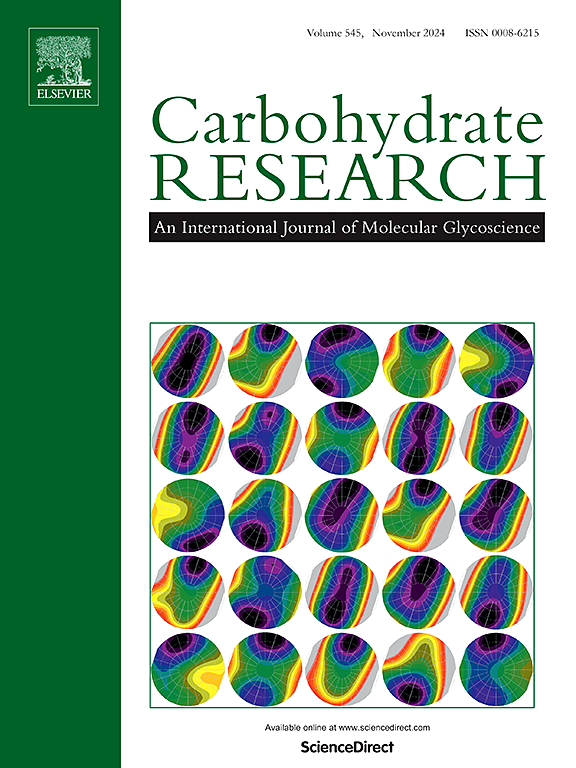湖南黄精多糖及其衍生物的制备、结构鉴定及体外活性研究
IF 2.5
3区 化学
Q3 BIOCHEMISTRY & MOLECULAR BIOLOGY
引用次数: 0
摘要
多糖是湖南黄精(Polygonatum hunanense)的主要活性成分之一。本研究采用水提法和乙醇沉淀法从白参根中提取多糖。此外,PHP通过各种技术分离纯化,特别是通过DEAE-52纤维素和Sephadex G-100色谱柱。结构分析表明,PHP由94.9%的果糖和5.1%的葡萄糖组成,分子量为6.01 kDa。此外,主链的PHP残留连杆被发现β-D-Fruf -(2→6)-D-Glcp -(1→2)β-D-Fruf -(1→2)β-D-Fruf -(1→2)β-D-Fruf。支链分析显示,存在→2)-β- d - fruf -(1,6→2)-β- d - fruf -(1→2)-β- d - fruf。随后,对PHP进行化学修饰,得到乙酰化多糖(Ac-PHP)和硫酸化多糖(Su-PHP)。傅里叶变换红外光谱和13C核磁共振光谱的鉴定结果表明,多糖的衍生化反应成功。体外生物活性实验表明,PHP、Ac-PHP和Su-PHP可诱导细胞凋亡,影响细胞周期,对肿瘤细胞具有细胞毒性。与PHP相比,Ac-PHP和Su-PHP在所有组中均表现出增强的效果。这些结果表明,PHP可能是一种很有前景的癌症治疗的候选和补充,而乙酰化和磺化的PHP多糖可能通过改变其结构来增强其抗肿瘤活性。本文章由计算机程序翻译,如有差异,请以英文原文为准。

Preparation, structural identification, and in vitro activity study of polysaccharides and derivatives from Polygonatum hunanense
Polysaccharides are one of the main active components of Polygonatum hunanense (PHP). This study extracted polysaccharides from the roots of PHP using water extraction and ethanol precipitation methods. Additionally, PHP was isolated and purified through various techniques, particularly through Diethylaminoethyl-52 (DEAE-52) cellulose and Sephadex G-100 chromatography columns. Structural analysis revealed that PHP is composed of 94.9 % fructose and 5.1 % glucose, with a molecular weight of 6.01 kDa. Moreover, the main chain of PHP residues linkage was found to be β-D-Fruf-(2 → 6)-D-Glcp-(1 → 2)-β-D-Fruf-(6,1 → 2)-β-D-Fruf-(1 → 2)-β-D-Fruf. Branch chain analysis revealed the presence of →2)-β-D-Fruf-(1, 6 → 2)-β-D-Fruf-(1 → 2)-β-D-Fruf. Subsequently, PHP was chemically modified, yielding acetylated polysaccharides (Ac-PHP) and sulfated polysaccharides (Su-PHP). The identification results from Fourier-transform infrared spectroscopy and 13C nuclear magnetic resonance spectra indicated the successful derivatization of the polysaccharides. In vitro bioactivity experiments demonstrated that PHP, Ac-PHP, and Su-PHP can induce cell apoptosis and affect the cell cycle, leading to cytotoxicity toward tumor cells. Compared to PHP, Ac-PHP and Su-PHP exhibited enhanced effects in all groups. These results suggest that PHP might be a promising candidate and supplement for cancer treatment, while the acetylated and sulfated PHP polysaccharides may enhance their antitumor activity by altering their structures.
求助全文
通过发布文献求助,成功后即可免费获取论文全文。
去求助
来源期刊

Carbohydrate Research
化学-生化与分子生物学
CiteScore
5.00
自引率
3.20%
发文量
183
审稿时长
3.6 weeks
期刊介绍:
Carbohydrate Research publishes reports of original research in the following areas of carbohydrate science: action of enzymes, analytical chemistry, biochemistry (biosynthesis, degradation, structural and functional biochemistry, conformation, molecular recognition, enzyme mechanisms, carbohydrate-processing enzymes, including glycosidases and glycosyltransferases), chemical synthesis, isolation of natural products, physicochemical studies, reactions and their mechanisms, the study of structures and stereochemistry, and technological aspects.
Papers on polysaccharides should have a "molecular" component; that is a paper on new or modified polysaccharides should include structural information and characterization in addition to the usual studies of rheological properties and the like. A paper on a new, naturally occurring polysaccharide should include structural information, defining monosaccharide components and linkage sequence.
Papers devoted wholly or partly to X-ray crystallographic studies, or to computational aspects (molecular mechanics or molecular orbital calculations, simulations via molecular dynamics), will be considered if they meet certain criteria. For computational papers the requirements are that the methods used be specified in sufficient detail to permit replication of the results, and that the conclusions be shown to have relevance to experimental observations - the authors'' own data or data from the literature. Specific directions for the presentation of X-ray data are given below under Results and "discussion".
 求助内容:
求助内容: 应助结果提醒方式:
应助结果提醒方式:


